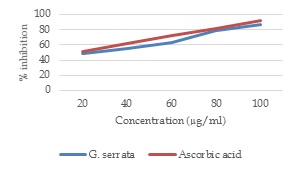Preliminary Phytochemical Analysis and Antioxidants Activities of Ethanolic Extract from Gomphrena serrata Whole Plant
Abstract
The present study was designed to investigate the phytochemical analysis and antioxidant activities of the whole plant of Gomphrena serrata. Gomphrena serrata widely distributed in South America, North America, and India. These plant parts are used as traditional medicine for the treatment of several ailments. This study aims to assess the phytochemical and free radical scavenging of ethanolic extract of G. serrata present in the plant. The preliminary phytochemical study was performed by standard method. The whole plant of G. serrata proved the presence of bioactive constituents such as carbohydrates, alkaloids, steroids, glycosides, triterpenoids, protein and amino acids, saponins, as well as flavonoids. The in-vitro antioxidant study was performed on the ethanolic extract of shade-dried of the whole plant, which determined by hydrogen peroxide, hydroxyl radical, and 1,1-diphenyl-2-picrylhydrazyl (DPPH) 100 µg/ml assay and was compared to ascorbic acid. The ethanolic extract of the whole plant of G. serrata shows the strong free radical scavenging activity. The present study was the proof for ethanol extract of G. serrata which have medicinally significant and bioactive compounds since these plant species are used as traditional medicine for the treatment of various diseases.
Full text article
References
Altemimi, A., Lakhssassi, N., Baharlouei, A., Watson, D.G., & Lighfoot, D.A. (2017). Phytochemicals: Extraction, Isolation, and Identification of Bioactive Compounds from Plant Extracts. Plants, 6(4), 42. doi: 10.3390/plants6040042
Di Meo, S., Reed, T.T., Venditti, O., & Victor, V.M. (2016). Role of ROS and RNS Sources in Physiological and Pathological Conditions. Oxidative Medicine and Cellular Longevity, 2016, 1245049. doi: 10.1155/2016/1245049
Ekor, M. (2013). The growing use of herbal medicines: issues relating to adverse reactions and challenges in monitoring safety. Frontiers in Pharmacology, 4, 177. doi: 10.3389/fphar.2013.00177
Gülçin, I., Berashvili, D., & Gepdiremen, A. (2005). Antiradical and antioxidant activity of total anthocyanins from Perilla pankinensis decne. Journal of Ethnopharmacology, 101(1-3), 287-293. doi: 10.1016/j.jep.2005.05.006
Kedare, S.B. & Singh, R.P. (2011). Genesis and development of DPPH method of antioxidant assay. Journal of Food Science and Technology, 48(11), 412-422. doi: 10.1007/s13197-011-0251-1
Khadabadi, S.S., Deore, S.L., & Baviskar, B.A. (2013). Experimental Phytopharmacognosy. 2nd edition. Pune, India: Nirali Prakahsan.
Khandelwal, K.R. (2006). Practical Pharmacognosy. 16th edition (pp. 149-153). Pune, India: Nirali Prakahsan.
Kumar, S., Dobos, G.J., & Rampp, T. (2017). The Significance of Ayurvedic Medicinal Plants. Journal of Evidence-Based Complementary & Alternative Medicine, 22(3), 494-501. doi: 10.1177/2156587216671392
Kurutas, E.B. (2016). The importance of antioxidants which play the role in cellular response against oxidative/nitrosative stress: current state. Nutrition Journal, 15, 71. doi: 10.1186/s12937-016-0186-5
Nandini, K.N., Palaksha, M.N., & Gnanasekaran, D. (2018). A review of Gomphrena serrata. International Journal of Science and Research Methodology, 11(1), 492-503.
Pavithra, T. & Mani, T.T. (2019). Preliminary Phytochemical Evaluation and In-Vitro Antioxidant Studies on Leaves of “Odina wodier Roxb”. European Journal of Pharmaceutical and Medical Research, 6(5), 732-739.
Phaniendra, A., Jestadi, D.B., & Periyasamy, L. (2015). Free Radicals: Properties, Sources, Targets, and Their Implication in Various Diseases. Indian Journal of Clinical Biochemistry, 30(1), 11-26. doi: 10.1007/s12291-014-0446-0
Pizzino, G., Irrera, N., Cucinotta, M., Pallio, G., Mannino, F., Arcoraci, V., Squadrito, F., Altavilla, D., & Bitto, A. (2017). Oxidative Stress: Harms and Benefits for Human Health. Oxidative Medicine and Cellular Longetivity, 2017, 8416763. doi: 10.1155/2017/8416763
Rahman, A.H.M. & Gulshana, M.I.A. (2014). Taxonomy and Medicinal Uses on Amaranthaceae Family of Rajshahi, Bangladesh. Applied Ecology and Environmental Sciences, 2(2), 54-59. doi: 10.12691/aees-2-2-3
Ruch, R.J., Cheng, S.J., & Klaunig, J.E. (1989). Prevention of cytotoxicity and inhibition of intercellular communication by antioxidant catechins isolated from Chinese green tea. Carcinogenesis, 10(6), 1003-1008. doi: 10.1093/carcin/10.6.1003
Sen, S. & Chakraborty, R. (2016). Revival, modernization and integration of Indian traditional herbal medicine in clinical practice: Importance, challenges and future. Journal of Traditional and Complementary Medicine, 7(2), 234-244. doi: 10.1016/j.jtcme.2016.05.006
Shrestha, P., Adhikari, S., Lamichhane, B., & Shresta, B.G. (2015). Phytochemical Screening of the Medicinal Plants of Nepal. IOSR Journal of Environmental Science, Toxicology and Food Technology, 1(6), 11-17.
Smirnoff, N. & Cumbes, Q.J. (1989). Hydroxyl radical scavenging activity of compatible solutes. Phytochemistry, 28(4), 1057-1060. doi: 10.1016/0031-9422(89)80182-7
Sofowora, A., Ogunbodede, E., & Onayade, A. (2013). The Role and Place of Medicinal Plants in the Strategies for Disease Prevention. African Journal of Traditional, Complementary and Alternative Medicines, 10(5), 210-229. doi: 10.4314/ajtcam.v10i5.2
Umamaheswari, M. & Chatterjee, T.K. (2007). In vitro antioxidant activities of the fractions of Coccinia grandis L. leaf extract. African Journal of Traditional, Complementary and Alternative Medicines, 5(1), 61-73.
Authors
Copyright (c) 2020 Kodukothanahalli Naganna Nandini, Mekerahalli Narayanappa Palaksha, Belakavadi Shivalingu Mamatha, Anasosalu Ramesh Lekhana

This work is licensed under a Creative Commons Attribution-ShareAlike 4.0 International License.
This work is licensed under a Creative Commons Attribution-ShareAlike 4.0 International License.
Authors continue to retain the copyright to the article if the article is published in the Borneo Journal of Pharmacy. They will also retain the publishing rights to the article without any restrictions.
Authors who publish in this journal agree to the following terms:
- Any article on the copyright is retained by the author(s).
- The author grants the journal the right of first publication with the work simultaneously licensed under a Creative Commons Attribution License that allows others to share work with an acknowledgment of the work authors and initial publications in this journal.
- Authors can enter into separate, additional contractual arrangements for the non-exclusive distribution of published articles (e.g., post-institutional repository) or publish them in a book, with acknowledgment of their initial publication in this journal.
- Authors are permitted and encouraged to post their work online (e.g., in institutional repositories or on their websites) prior to and during the submission process. This can lead to productive exchanges and earlier and greater citations of published work.
- The article and any associated published material are distributed under the Creative Commons Attribution-ShareAlike 4.0 International License.




